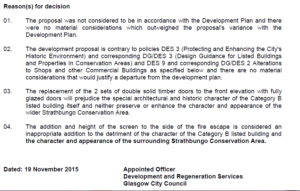What is being proposed
The word charrette is French for “cart”. In the École des Beaux-Arts in Paris in the 19th century, it was not unusual for student architects to continue working furiously in teams at the end of the allotted term, up until a deadline, when a charrette would be wheeled among the students to pick up their scale models and other work for review while they, each working furiously to apply the finishing touches, were said to be working en charrette, in the cart. The term evolved into the current design-related usage in conjunction with working right up until a deadline and through support from the Scottish Government is now linked to intensive community planning events.
Pollokshields Community Council (PCC) have now obtained most of the funding needed to work with the community and stakeholders to produce a revised community based plan for east Pollokshields and surrounding areas. This includes part of Strathbungo, encompassing Nithsdale Rd, Street and Drive (see map). PCC are planning to hold an intensive event, the charrette, over four days at the end of February out of which a detailed set of proposals and designs will be produced.
The Strathbungo Society, which discussed this at its Committee meeting yesterday, sees this as a great opportunity to progress some proposals that have been circulating for some time, but never developed, as well as developing new ideas with residents. Past proposals have included re-design of the Nithsdale roundabout, landscaping of the Nithsdale Rd cul de sac and removal of litter bins from pavements and improving cycle lane connections.
The charrette is also important because what happens around Strathbungo affects the quality of life here. So it’s a chance to influence what goes on in East Pollokshields, which many Strathbungo residents visit regularly, if not daily – including the other side of the railway line along Moray Place! The charrette includes the area around Eglinton toll that lies between Strathbungo and the City Centre and has plenty of potential for improvement.
Pollokshields Community Council want to work with the community and stakeholders to complete the East Pollokshields and Port Eglinton Planning Study as a masterplan document that, as Supplementary Planning Guidance to the new City Development Plan, can help guide the next two decades of development in the area. The Strathbungo Society also see this as an opportunity to embed the Strathbungo Conservation area appraisal into planning documents. Glasgow City Council have agreed to support the proposal with officer time.
The Strathbungo Society will post more information about the charrette in the New Year including how to get involved.
Further explanation and detail provided by Pollokshields Community Council
The need for the study was previously outlined in Glasgow City Council’s City Plan 2 Part 2 – Development Strategy Priorities & Proposals: The Rest of the City: Areas Requiring Targeted Planning Action 8.23 East Pollokshields/Port Eglinton Planning Study. Preparatory work proceeded with the East Pollokshields/ Port Eglinton Planning Study – Resident Survey published in August 2008. The need for the Planning Study was agreed with officers as part of the autumn 2008 Public Local Inquiry into the draft City Plan 2 hence its inclusion in the final document. However, work on the study stalled thereafter. Reference was again made to the need for the East Pollokshields and Port Eglinton planning study in the Main Issues Report (re: Map 3 – the Spatial Planning Activity Framework, Other Studies, Item 34), but there was no reference in the draft City Development Plan published in Spring 2014. The PCC raised concerns with GCC as part of the LDP consultation process requesting that the area be included in the Local Development Framework for the Southside.
However, at a meeting in December 2014 with Nicola Sturgeon MSP, a representative for Anas Sarwar MP, and the three local Councillors, GCC Planning officers confirmed that financial pressures were such they would not be able to conclude the study for at least another decade i.e. 17 years after the need for the study was first highlighted. Recognising the reality of resourcing issues for GCC DRS producing it, the PCC is therefore seeking a community led charrette as a way to drive this forward in order to tackle the multiple deprivations from which the area suffers, and improve the lives and economic outcomes for the people who live in East Pollokshields.
The PCC believe a charrette to be the best forum in which to assemble the community and stakeholders in one place and rapidly work through the issues, draft out, agree and conclude the contents, aims and outcomes of the study
The PCC wants to complete the planning study and have it adopted as Supplementary Planning Guidance by GCC DRS so the study must be couched in terms of the policies outlined in the proposed City Development Plan in particular Policy CDP 1 The Placemaking Principle. The planning study will also align with the aims of all relevant Scottish Government policies and principles for development, regeneration and community empowerment so that our neighbourhood achieves its full potential to be:
· distinctive;
· safe and pleasant;
· easy to move around and beyond;
· welcoming;
· adaptable; and
· resource efficient.
· economically vibrant
East Pollokshields is a planned tenemental suburb with a population of 8,206 located on the Southside of Glasgow approximately 2km from George Square. It is the most multi-cultural area in both Glasgow and Scotland with a BME population share of 52%. This figure is far higher than those for Glasgow at 11.6% and for Scotland at 4.0%. Between 2001 and 2013 East Pollokshields’ population rose by 16% – one the highest rates of increase in Glasgow. More than a quarter of households in East Pollokshields are overcrowded, 33% of children live in poverty, 93.5% of people live within 500m of vacant or derelict land while SIMD Data Zone: S01003256 – the north of East Pollokshields – has an SIMD 2012 rank of 195 out of 6505 data zones in Scotland. Centred on Albert Drive (a Tier 3 Town Centre in Glasgow)
East Pollokshields dates from 1848 becoming a conservation area in 1973. The Victorian tenements are now aging and difficult to heat. There are rubbish and recycling issues with numerous incidences of fly tipping. Neighbouring Port Eglinton; however, is a derelict industrial zone with large tracts of brownfield land that offer significant regeneration opportunities.
The charrette is currently programmed for the week commencing 21st February 2016.
Key issues the charrette will deal with:
The PCC strongly feel that the planning study is required to address several local issues including:
· Severance between East Pollokshields / Port Eglinton and Glasgow city centre
· An undersupply of Green and Amenity space within East Pollokshields
· Environmental Improvements such as upgraded public realm, reinstatement of
historic shop fronts of Albert Drive and improved maintenance of historic built
fabric as part of a potential Townscape Heritage scheme or Conservation Area
Regeneration Scheme
· Local concerns about stalled development spaces
· Contaminated land issues
· A strategy for Recreation space
· Refuse and Recycling issues + fire raising issues in tenement closes
· How to maximise the energy efficiency of aging built fabric so as to create
warm homes
· An examination of tenure and type with a focus on conditions in the private
rental sector
· Tailoring housing supply to the needs of large families
· Local health issues
· Local employment issues
· Generation of local power and CHP
· Transport Strategy including alternatives to inner city car use
· Retrofitting tenemental streets to meet Designing Streets, Homezone
standards and 20MPH zones
· The designation under the City Development Plan of sites H073 (60 Maxwell
Road with a lapsed planning consent for 261 housing units) and H081 (55
Maxwell Road with a lapsed consent for 200 units) and how these can comply
with Policy CDP 1 The Placemaking Principle and good urban design
· The setting aside under Policy CDP 11 Sustainable Transport land for an
interchange station at West Street that would link the high level lines and the
subway.
· The growing population in East Pollokshields and the needs of its unique
multicultural population – by far the most multicultural in Scotland.
Key Charrette outputs:
· Completion of the East Pollokshields and Port Eglinton Planning Study as
SPG to new City Development Plan.
· Establishment of Development Trust
· Environmental Improvements
· Promotion of alternate modes of transport
· Townscape Heritage scheme and Conservation Area Regeneration Scheme
submissions
· Design proposals + codes for City Development Plan sites H073 and H081
· Cycle and pedestrian route to West Street subway station
· Specialist study on regeneration potential











 #b
#b














Recent Comments